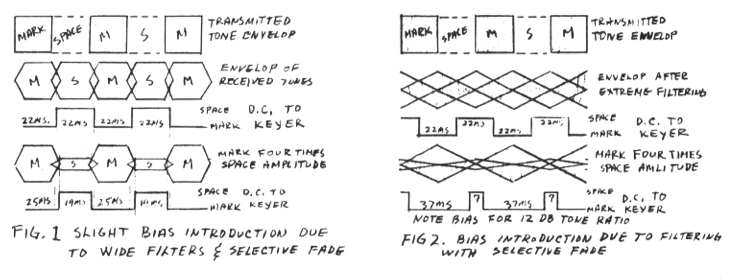Frank Gaudé is the first amateur to use and promote limiterless demodulators for RTTY.
Gaudé founded Echelon, Inc. which sold the Z-System operating system. He is the author of the MODEM7 extension of XMODEM. Before his RTTY days, Mr. Gaudé held an earlier call W4ONJ. He moved to Huntsville, Alabama and used W4DDE for some years before moving back to California, after which his amateur radio license expired.
"A New Approach to TU Design Using a Limiterless Two-Tone Method." RTTY Bulletin, June 1963. (Reprinted in the January 1964 Issue.)
This is the
seminal article of what we today call the "AM" method of
FSK demodulation. The article also points to other
effects, such as the behavior of matched filters under
selective fading conditions.
Selective fading causes the mark signal amplitude to be randomly different from the space signal amplitude. Mr. Gaudé writes "These relative amplitude fades between mark and space frequencies causes serious trouble and results in errors in the convention TU of the limiter-discriminator variety. These errors due to selective fade are produced even if the S/N ratio is high for both of the frequencies involved." [emphasis is mine: kc]
Mr. Gaudé points out that up to that time, all demodulators that were used by amateurs, except for the Gates demodulator, had included a limiter. He also observes correctly that limiterless demodulation turns "this selective fade disadvantage for the conventional TU into an actual advantage and provide true frequency diversity reception." [emphasis is again mine: kc]
By "conventional TU," Gaudé refers to what we today call the "FM method" of FSK demodulation.
Gaudé explains why there is a problem with a limiter in his Figs 1 and 2 (this was shown earlier but because of its importance, is shown again here).

Notice in his Figure 1 that an input with an equal mark/space ratio results in an output keying waveform that does not have an equal mark/space ratio.
In the days of 850 Hz FSK shifts, two narrow filters placed around the mark and space signals to reject interference in between the tone pairs were called "comb" filters, Figure 2 shows that the output degenerates even further when you apply the comb filter (the triangular envelope is reminiscent of a Matched Filter output). Gaudé noted that the mark/space ratio error in the output exists even when the signal to noise ratio, as shown, is very high.
(Note that a use of a comb filter is similar in todays world of using a "dual peak filter" in the receiver.)
Gaudé also makes an interesting observation that "matched filter theory does not apply when the tones are experiencing a selective fade."
Gaudé further makes a probabilistic estimate that right when one tone fades while the other tone still has good S/N ratio, an FM detector will still produce more than 25% bit errors.
Please refer to the earlier AM vs FM page for a more detailed discussion of Gaudé's slideback detector compared to what was know in the art at the time he wrote this article. Included in that discussion is a short description of the circuit which Gaudé had used as a countermeasure to unequal Mark and Space amplitudes.
Selective fading causes the mark signal amplitude to be randomly different from the space signal amplitude. Mr. Gaudé writes "These relative amplitude fades between mark and space frequencies causes serious trouble and results in errors in the convention TU of the limiter-discriminator variety. These errors due to selective fade are produced even if the S/N ratio is high for both of the frequencies involved." [emphasis is mine: kc]
Mr. Gaudé points out that up to that time, all demodulators that were used by amateurs, except for the Gates demodulator, had included a limiter. He also observes correctly that limiterless demodulation turns "this selective fade disadvantage for the conventional TU into an actual advantage and provide true frequency diversity reception." [emphasis is again mine: kc]
By "conventional TU," Gaudé refers to what we today call the "FM method" of FSK demodulation.
Gaudé explains why there is a problem with a limiter in his Figs 1 and 2 (this was shown earlier but because of its importance, is shown again here).

Notice in his Figure 1 that an input with an equal mark/space ratio results in an output keying waveform that does not have an equal mark/space ratio.
In the days of 850 Hz FSK shifts, two narrow filters placed around the mark and space signals to reject interference in between the tone pairs were called "comb" filters, Figure 2 shows that the output degenerates even further when you apply the comb filter (the triangular envelope is reminiscent of a Matched Filter output). Gaudé noted that the mark/space ratio error in the output exists even when the signal to noise ratio, as shown, is very high.
(Note that a use of a comb filter is similar in todays world of using a "dual peak filter" in the receiver.)
Gaudé also makes an interesting observation that "matched filter theory does not apply when the tones are experiencing a selective fade."
Gaudé further makes a probabilistic estimate that right when one tone fades while the other tone still has good S/N ratio, an FM detector will still produce more than 25% bit errors.
Please refer to the earlier AM vs FM page for a more detailed discussion of Gaudé's slideback detector compared to what was know in the art at the time he wrote this article. Included in that discussion is a short description of the circuit which Gaudé had used as a countermeasure to unequal Mark and Space amplitudes.
"Two-Tone, Shifts and Filters" Part I in RTTY Bulletin, September 1963, Part II appeared in the February 1964 issue.
A significant
statement by Gaudé in Part II is that studies show that
selective fading is moderately independent of the FSK
shift at least down to the 170 Hz region.